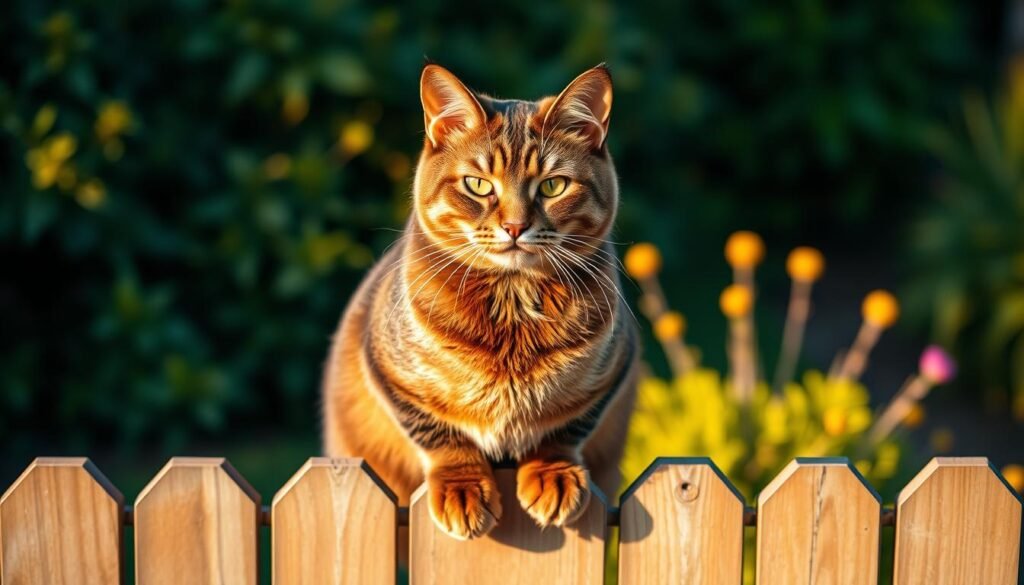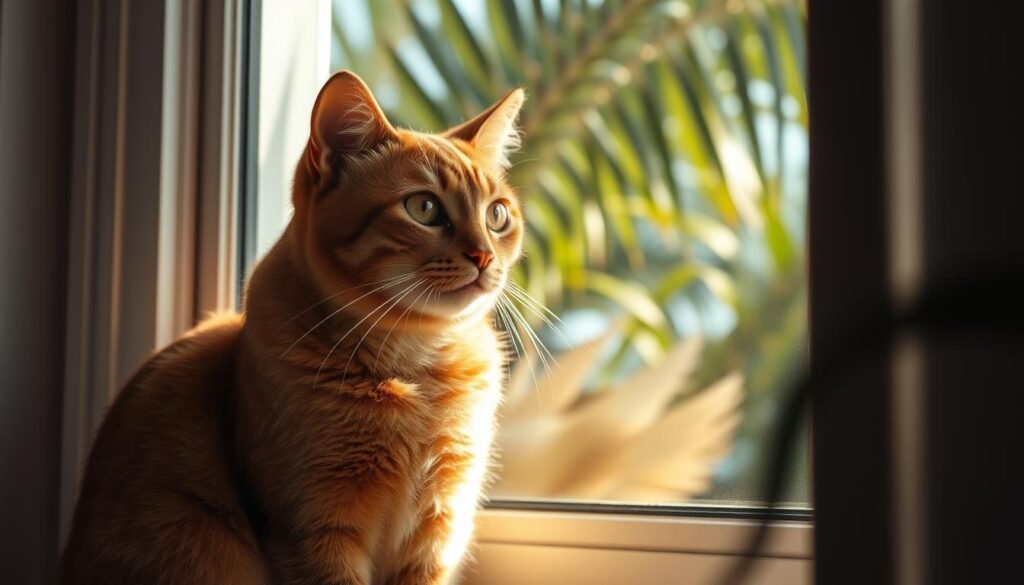Brown Cat Breeds: Unique Feline Varieties & Their Traits
Brown Cat Breeds Imagine coming home to a pair of warm, amber eyes gleaming from a sunlit windowsill. There’s something undeniably special about felines with rich, earthy coats—their colors mirror autumn leaves or freshly brewed coffee. Whether you’re drawn to sleek chocolate hues or caramel-striped patterns, these unique companions bring warmth to any space.
This guide explores distinct feline varieties known for their striking coats. You’ll discover how their fur patterns range from solid mahogany to subtle tabby swirls. But it’s not just about looks—their personalities shine just as brightly. Some are playful acrobats, while others prefer quiet evenings curled beside you.
We’ll dive into their histories, care needs, and standout quirks. For example, did you know certain types thrive on interactive play? Others might surprise you with their dog-like loyalty. You’ll also learn practical tips, like grooming routines that keep their coats glossy.
By the end, you’ll have a clearer picture of which warm-toned friend could fit your lifestyle. Ready to meet these captivating companions? Let’s begin.
Table of Contents
Introduction to These Enchanting Brown Cat Breeds
There’s a quiet magic in the gaze of a feline whose coat mirrors the deep tones of mahogany. These companions captivate not just with their striking color but with personalities as rich as their fur. Their coats range from velvety cocoa to golden cinnamon—each shade telling its own story.
What makes these felines so sought-after? It’s the rarity of finding an all-brown variety, like the Havana Brown, whose sleek appearance resembles polished chestnut. While some display subtle tabby stripes, others boast solid hues that glow in sunlight. Their eyes often contrast beautifully, with greens and ambers that seem to hold secrets.
“Their elegance isn’t accidental,” says one feline historian. Many trace their origins to selective breeding efforts, blending mystery with intentional design. You’ll soon discover how factors like genetics and geography shaped their distinct looks and temperaments.
Throughout this guide, you’ll explore:
- How coat patterns influence personality traits
- Historical quirks behind specific lineages
- Care strategies tailored to their unique needs
Whether you’re drawn to playful energy or serene companionship, these felines offer both. Ready to uncover what makes each one extraordinary? Let’s dive deeper.
Exploring Brown Cat Breeds and Their Characteristics

From sleek chocolate shades to cinnamon swirls, these felines showcase nature’s artistry in fur form. Their coats vary widely—some feel like crushed velvet, while others have a glossy satin finish. For instance, the Havana Brown sports a uniform mahogany hue, whereas the Burmese displays a gradient from warm sable to golden undertones.
Size differences stand out too. While one breed might weigh 8-10 pounds with a muscular frame, another could be petite at 6-8 pounds. Personality traits diverge just as sharply. Some thrive in playful chaos, climbing curtains with acrobatic flair. Others prefer serene observation from a cozy perch.
Patterns add another layer of uniqueness. A mackerel tabby’s striped legs contrast with a ticked coat’s speckled appearance. “The right pattern can highlight a feline’s structure,” notes a certified breeder. Solid-colored types often draw attention to their eye color, creating striking visual harmony.
When choosing your companion, consider:
- Coat maintenance needs (short vs. long fur)
- Energy levels matching your lifestyle
- Social tendencies toward humans or other pets
Understanding these traits helps you appreciate what makes each breed extraordinary. Whether drawn to vocal chatterboxes or quiet observers, there’s a warm-toned match waiting to steal your heart.
The Fascinating History Behind the Havana Brown

Step into the 1950s, when British breeders crafted a feline masterpiece. The Havana Brown emerged from crossing black domestic shorthairs with chocolate point Siamese cats. This deliberate pairing aimed to create a uniform mahogany coat—a rarity in feline genetics.
Records show the breed gained official recognition in 1958. By 1970, its name evolved from “Chestnut Brown Foreign” to reflect its warm, cigar-inspired hues. Early enthusiasts praised its distinctive appearance, featuring oval green eyes and a tapered muzzle.
| Year | Milestone | Impact |
|---|---|---|
| 1950s | Crossbreeding begins | Foundation for chocolate coat |
| 1958 | Official recognition | Established breed standard |
| 1970 | Name change | Strengthened brand identity |
What makes this Havana Brown cat stand out? Its glossy coat requires minimal grooming yet shines like liquid cocoa. “They’re living art pieces,” notes a CFA-certified judge. “The paw pads match their fur—a detail breeders carefully preserve.”
Despite modern trends, the breed’s traits remain unchanged. Its playful yet calm temperament continues winning hearts globally. Whether chasing toys or lounging in sunbeams, this chocolate-hued companion bridges past elegance with present-day charm.
Diverse Coat Patterns and Unique Feline Features
Ever noticed how sunlight reveals hidden details in a feline’s fur? Their coat patterns act like nature’s fingerprint—no two are exactly alike. From swirling stripes to speckled gradients, these designs tell stories of genetics and ancestry.
Common Brown Patterns: Tabby, Mackerel, and Ticked
Classic tabby coats display bold swirls resembling marble. Mackerel types feature narrow vertical stripes like fishbones. Ticked varieties? Each hair shows multiple shades, creating a salt-and-pepper effect. “These patterns evolved for camouflage,” explains a feline geneticist. “Mackerel stripes mimic tall grass shadows.”
| Pattern | Key Trait | Example Breed |
|---|---|---|
| Tabby | Swirling bullseye | American Shorthair |
| Mackerel | Parallel stripes | Egyptian Mau |
| Ticked | Speckled hairs | Abyssinian |
Exotic Variations: Tortoiseshell and Pointed Patterns
Tortoiseshell coats blend chocolate and amber in flame-like patches. Pointed patterns contrast darker ears and tails with lighter bodies—a trait linked to temperature-sensitive genes. These rarer colors often signal mixed heritage or specialized breeding programs.
Whether your companion sports subtle tabby marks or dramatic tortoiseshell swirls, their brown coat becomes a canvas of history. Next time they stretch in sunlight, look closer—you might spot new patterns emerging.
Loving Care: Nutrition, Grooming, and Health Tips for Your Cat
Your feline companion thrives when care becomes part of your daily rhythm. Tailoring routines to their needs ensures they stay vibrant and content. Let’s explore how to build habits that support their well-being.
Fueling Vitality Through Smart Nutrition
High-quality food matters. Choose age-appropriate formulas—kittens need more protein, while seniors benefit from joint support. Measure portions using a kitchen scale to avoid overfeeding. A 10-pound adult typically requires 240–280 calories daily.
Watch for hidden calories in treats. Swap processed snacks with cooked chicken or freeze-dried fish. Hydration is key: place water bowls away from food to encourage drinking. “Canned food adds moisture,” notes a veterinary nutritionist, “which helps urinary health.”
Grooming and Wellness Made Simple
Short-haired varieties like the Havana Brown need weekly brushing. Long-haired pets? Aim for daily sessions. Trim nails every 2–3 weeks, avoiding the pink paw pads. Introduce tooth brushing early—use poultry-flavored paste for cooperation.
Schedule annual vet exams. Weight checks catch issues early. For multi-pet homes, track each family member’s eating habits. Playtime isn’t just fun—20 minutes daily reduces stress and strengthens bonds.
| Care Task | Frequency | Tips |
|---|---|---|
| Brushing | 1–7x/week | Adjust based on fur length |
| Nail Trims | Monthly | Use guillotine-style clippers |
| Dental Care | Daily | Start with finger brushes |
Remember, your attention shapes their personality. A cozy bed near your workspace or interactive toys keeps them engaged. Love isn’t just cuddles—it’s creating a home where they flourish.
Other Brown Cat Breeds and Their Distinct Traits
Have you ever marveled at how a single color can express so many personalities? Beyond the Havana Brown, other warm-toned felines showcase striking contrasts in structure and temperament. Let’s explore three standout varieties that redefine earthy elegance.
From Burmese to Bengal: A Look at Varied Appearances
The Burmese flaunts a sable-colored coat resembling melted caramel. Their rounded face and expressive gold eyes radiate approachability. Unlike the Havana Brown’s angular muzzle, this type has a compact, muscular frame perfect for climbing bookshelves.
Bengals turn heads with their wild-inspired patterns. Rosettes and marbled stripes mimic jungle ancestors, while their glittered fur shimmers under light. One breeder notes: “Their paw pads often match coat undertones—chocolate hues pair with brick-red toe beans.”
| Breed | Coat Detail | Eye Color | Temperament |
|---|---|---|---|
| Burmese | Solid sable | Gold | Affectionate chatterbox |
| Bengal | Rosetted stripes | Green/Amber | High-energy explorer |
| Abyssinian | Ticked layers | Hazel | Curious acrobat |
Abyssinians break the mold with agouti-ticked fur—each hair bands multiple shades. Their almond-shaped eyes and large ears create a fox-like appearance. While Havana Browns prefer relaxed play, these athletes leap door frames effortlessly.
When choosing your companion, consider how patterns and energy levels align with your lifestyle. The right match isn’t just about colors—it’s finding a personality that complements your home’s rhythm.
Conclusion
Choosing a feline companion with warm-toned fur offers more than beauty—it’s a lifestyle match. From the Havana Brown’s 1950s origins to the ticked coats of Abyssinians, each cat breed carries a legacy shaped by genetics and care. Their coat patterns—whether tabby swirls or tortoiseshell patches—act as living art pieces, blending history with modern charm.
Proper care keeps these pets thriving. Tailor nutrition to their age and activity level, and prioritize regular vet checkups. Short-haired varieties like the Oriental Shorthair need minimal grooming, while playful Bengals demand interactive toys to channel their energy.
When selecting your pet, consider how their personality aligns with your home dynamics. Quiet observers suit calm spaces, while vocal companions thrive in lively families. Their eyes and paw pads often mirror coat undertones, adding subtle elegance.
Ready to welcome one into your life? Review breed traits, consult breeders, and prepare a nurturing environment. Whether drawn to sleek silhouettes or wild-inspired patterns, your perfect match awaits—a brown-coated friend ready to enrich every moment.

